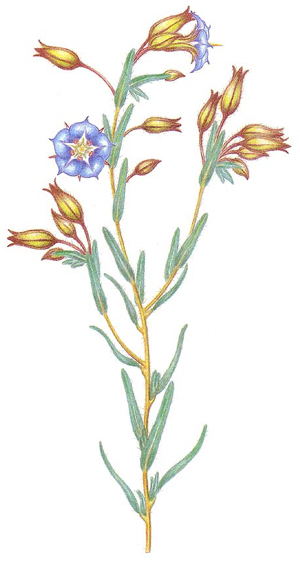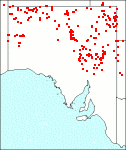Family: Boraginaceae
Trichodesma zeylanicum
Citation:
R. Br., Prod. Fl. Nov. Holl. 496 (1810).
Synonymy: Borago zeylanica Burm. f., Fl. Ind. 41, t. 14, fig. 2 (1768); T. zeylanicum (Burm. f.)R. Br. var. latisepalum F. Muell. ex Benth., Fl. Aust. 4:405 (1868).
Common name: Cattle bush, water bush, camel bush.
Description:
Annual herbs to perennials, shrubs to 1.2 m high, woody at least at the base, with a robust tap root, sparsely to densely branched, more or less densely covered with appressed or spreading fine short hairs together with scattered coarse long ones with a broad base; leaves opposite, and subpetiolate-cuneate below becoming alternate, sessile and cordate to rarely auriculate on or below the inflorescence, lanceolate to narrowly elliptic or oblong, rarely ovate; 2.5-12 x 0.5-2 cm, acute, with long hairs often restricted to the veins on the under surface.
Inflorescence terminal, with one to several scorpioid cymes with leaf-like bracts usually flower-opposed, pedicels 1-2.5 cm long; sepals scarcely connate basally, with lobes linear-lanceolate to ovate, 0.8-1.8 cm long and increasing after flowering, usually pointed; corolla rotate with tube continued into spreading part, dark-blue to rarely white, 13-18 mm long; lobes broadly ovate, 5-8 mm long, abruptly tapering into an often coiled point; stamens attached just below the throat of the corolla, with anthers sessile, narrowly triangular, 5-8 mm long, each with 2 rows of dorsal hairs spreading laterally and continued into a vertically coiled appendage and usually interlocking with those of the anthers to form a cone around the style; ovary not lobed, 4-celled with I ovule in each, surrounded by a nectary gland, with a terminal thread-like style terminating in an insignificant stigma.
Fruit with mericarps smooth or almost so.

| Flowering branch, half flower and mericarp in three views.
|
Image source: fig. 543 in Jessop J.P. & Toelken H.R. (Ed.) 1986. Flora of South Australia (4th edn).
|
Published illustration:
Cunningham et al. (1982) Plants of western New South Wales, p. 568; Rotherham et al. (1975) Flowers and plants of New South Wales and southern Queensland, fig. 510.
|
|
Distribution:
|
Usually found in sandy rarely in well drained gravelly soils.
W.Aust.; N.T.; Qld; N.S.W. India to south-east Asia.
|
Conservation status:
native
Flowering time: May — Oct.
|

SA Distribution Map based
on current data relating to
specimens held in the
State Herbarium of South Australia
|
Biology:
In spite of its common name it is rarely browsed by larger animals and is, in fact, suspected of cattle poisoning.
Taxonomic notes:
Although 2 varieties viz. var. latisepalum and var. sericeum (Lindley) Benth. have been described for plants from the NT, and at times used for S.Aust. plants, this variable taxon does not warrent subspecific subdivision in this State. The hairs do not only vary in their numbers, texture and distribution on various organs but also whether they are spreading or appressed sometimes varies even on different branches of the same collection. The sepals enlarge and particularly broaden much after flowering so that a wide variation can be found on the same plant.
Author:
Not yet available
|

